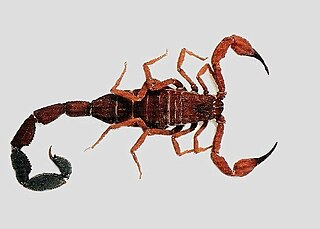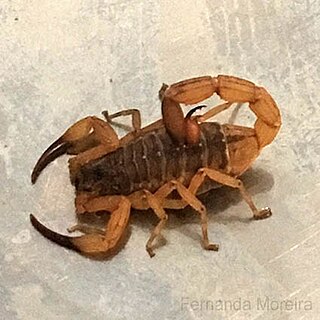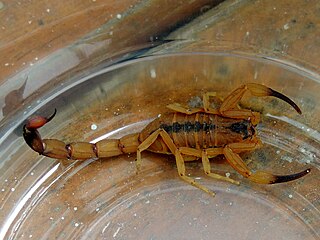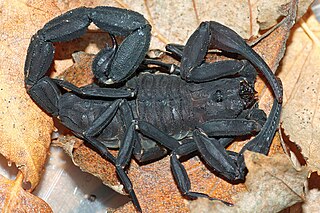
Phoneutria is a genus of spiders in the family Ctenidae. They are mainly found in northern South America, with one species in Central America. Members of the genus are commonly referred to as Brazilian wandering spiders. Other English names include armed spiders and banana spiders.
Paresthesia, also known as pins and needles, is an abnormal sensation of the skin with no apparent physical cause. Paresthesia may be transient or chronic, and may have many possible underlying causes. Paresthesias are usually painless and can occur anywhere on the body, but most commonly occur in the arms and legs.

Tityus is a large genus of thick-tailed scorpions, the namesake of its subfamily Tityinae. As of 2021, Tityus contains more than 220 described species distributed in Central America and South America, from Costa Rica to Argentina. Species in the genus Tityus have been studied for hundreds of years, long before the taxonomic classification was put in place. Tityus tend to be of medium size for scorpions, roughly 50 to 70 millimeters long. They are dark brown or red in color, and can exhibit sexual dimorphism. They can live in a variety of environments, ranging from urban to arid mountains to the Amazon Rainforest. Tityus scorpions are best known for their venom and potent sting. The genus contains several dangerously venomous scorpions, the best known of which is the Brazilian yellow scorpion, T. serrulatus. Its venom can cause severe illness, and in the young, old and infirm even death. Some experts have argued that the genus as a whole may be paraphyletic, which could explain the knowledge gaps related to Tityus.

A scorpion sting is an injury caused by the stinger of a scorpion resulting in the medical condition known as scorpionism, which may vary in severity. The anatomical part of the scorpion that delivers the sting is called a "telson". In typical cases, scorpion stings usually result in pain, paresthesia, and variable swelling. In serious cases, scorpion stings may involve the envenomation of humans by toxic scorpions, which may result in extreme pain, serious illness, or even death depending on the toxicity of the venom.

Hottentotta tamulus, the Indian red scorpion, also known as the eastern Indian scorpion, is a species of scorpion of the family Buthidae. It occurs in most of India, eastern Pakistan and the eastern lowlands of Nepal, and recently from Sri Lanka.

Tityus serrulatus, the Brazilian yellow scorpion, is a species of scorpion of the family Buthidae. It is native to Brazil, and its venom is extremely toxic. It is the most dangerous scorpion in South America and is responsible for the most fatal cases.
Tityus fasciolatus is a species of scorpion from the family Buthidae. The species are 4.5–8.5 centimetres (1.8–3.3 in) in length and are yellowish-brown coloured. They also have three dark stripes over the mesosoma with either yellowish or orange pedipalps, which have dark spots as well. Their first to third segments of metasoma is yellowish-orange, with the fourth one being reddish. Their fifth and final segment id dark red coloured. The species have yellow coloured legs which have dark spots, which are the same as on pedilap. Their tarsus is dark in colour with pectines that have 17-25 teeth, in which they have 16-18 rows of granules. T. fasciolatus is a species of medical importance, its venom is molecular and very similar to T. serrulatus, its venom contains at least 10 toxic fractions, with molecular masses ranging from 6 to 10-80 kDa, the LD50 for this species is 2.984 mg / kg.

Tityus stigmurus is a species of scorpion from the family Buthidae that can be found in Brazil. The species are 4.5–6 centimetres (1.8–2.4 in) in length and are either golden-tan or yellowish-brown coloured. It takes them a year to mature into an adult, which makes them a fast-growing species. They also have a dark stripe over the mesosoma with either yellowish or orange pedipalps.

Tityus apozonalli is an extinct species of scorpion in the family Buthidae known from a fossil found in North America. The species is one of two scorpions described from Mexican amber and one of seven species from Central American amber deposits.

Leiurus abdullahbayrami is a species of scorpion in the family Buthidae. Its venom is highly toxic to humans, but can be used in medical development.

Scorpionism is defined as the accidental envenomation of humans by toxic scorpions. If the injection of venom in a human results in death, this is defined as scorpionism. This is seen all over the world but is predominantly seen in the tropical and subtropical areas. These areas include Mexico, northern South America and southeast Brazil in the Western hemisphere. In the Eastern hemisphere, scorpionism possess a public health threat in the regions of South Africa, the Middle East, and the Indian subcontinent.

Tityus bahiensis is a medically important scorpion endemic to South America.

Tityus obscurus, known as the Amazonian black scorpion, is a species of scorpion found in northern South America.

Loxosceles intermedia, the Brazilian brown recluse spider, is a highly venomous spider species in the family Sicariidae native to Brazil and Argentina.

Loxosceles gaucho commonly known in English as the gaucho spider. is a highly venomous recluse spider endemic to South America.

Tityus discrepans is a species of scorpion found in northern and north-eastern South America.

Tityus pachyurus is a species of arachnid endemic to Central America and South America.

List of reported attacks and species involved in Latin America.
Tityus asthenes is a significantly venomous scorpion endemic to South America. Sometimes it is known as Peruvian black scorpion.
Tityus stigmurus toxin 1 (Tst1) is a neurotoxin found in the venom of the Brazilian scorpion, Tityus stigmurus. It acts on voltage-gated sodium channels (Navs), altering opening and inactivation voltages, recovery from inactivation, and overall current flow.














